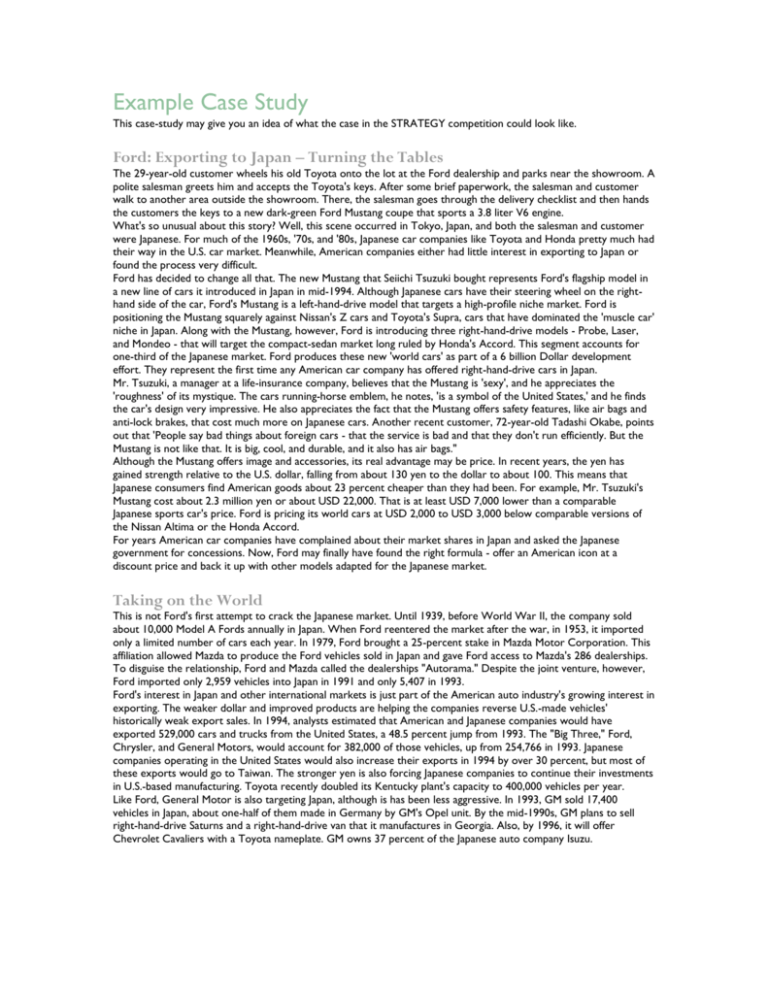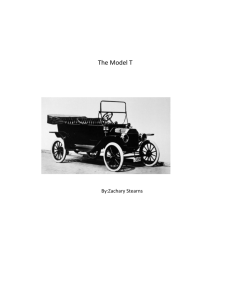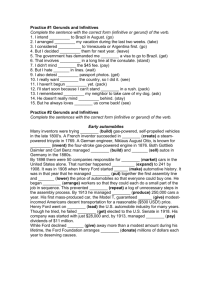Example Case Study - Industrial Engineering Department EMU-DAU
advertisement

Example Case Study This case-study may give you an idea of what the case in the STRATEGY competition could look like. Ford: Exporting to Japan – Turning the Tables The 29-year-old customer wheels his old Toyota onto the lot at the Ford dealership and parks near the showroom. A polite salesman greets him and accepts the Toyota's keys. After some brief paperwork, the salesman and customer walk to another area outside the showroom. There, the salesman goes through the delivery checklist and then hands the customers the keys to a new dark-green Ford Mustang coupe that sports a 3.8 liter V6 engine. What's so unusual about this story? Well, this scene occurred in Tokyo, Japan, and both the salesman and customer were Japanese. For much of the 1960s, '70s, and '80s, Japanese car companies like Toyota and Honda pretty much had their way in the U.S. car market. Meanwhile, American companies either had little interest in exporting to Japan or found the process very difficult. Ford has decided to change all that. The new Mustang that Seiichi Tsuzuki bought represents Ford's flagship model in a new line of cars it introduced in Japan in mid-1994. Although Japanese cars have their steering wheel on the righthand side of the car, Ford's Mustang is a left-hand-drive model that targets a high-profile niche market. Ford is positioning the Mustang squarely against Nissan's Z cars and Toyota's Supra, cars that have dominated the 'muscle car' niche in Japan. Along with the Mustang, however, Ford is introducing three right-hand-drive models - Probe, Laser, and Mondeo - that will target the compact-sedan market long ruled by Honda's Accord. This segment accounts for one-third of the Japanese market. Ford produces these new 'world cars' as part of a 6 billion Dollar development effort. They represent the first time any American car company has offered right-hand-drive cars in Japan. Mr. Tsuzuki, a manager at a life-insurance company, believes that the Mustang is 'sexy', and he appreciates the 'roughness' of its mystique. The cars running-horse emblem, he notes, 'is a symbol of the United States,' and he finds the car's design very impressive. He also appreciates the fact that the Mustang offers safety features, like air bags and anti-lock brakes, that cost much more on Japanese cars. Another recent customer, 72-year-old Tadashi Okabe, points out that 'People say bad things about foreign cars - that the service is bad and that they don't run efficiently. But the Mustang is not like that. It is big, cool, and durable, and it also has air bags." Although the Mustang offers image and accessories, its real advantage may be price. In recent years, the yen has gained strength relative to the U.S. dollar, falling from about 130 yen to the dollar to about 100. This means that Japanese consumers find American goods about 23 percent cheaper than they had been. For example, Mr. Tsuzuki's Mustang cost about 2.3 million yen or about USD 22,000. That is at least USD 7,000 lower than a comparable Japanese sports car's price. Ford is pricing its world cars at USD 2,000 to USD 3,000 below comparable versions of the Nissan Altima or the Honda Accord. For years American car companies have complained about their market shares in Japan and asked the Japanese government for concessions. Now, Ford may finally have found the right formula - offer an American icon at a discount price and back it up with other models adapted for the Japanese market. Taking on the World This is not Ford's first attempt to crack the Japanese market. Until 1939, before World War II, the company sold about 10,000 Model A Fords annually in Japan. When Ford reentered the market after the war, in 1953, it imported only a limited number of cars each year. In 1979, Ford brought a 25-percent stake in Mazda Motor Corporation. This affiliation allowed Mazda to produce the Ford vehicles sold in Japan and gave Ford access to Mazda's 286 dealerships. To disguise the relationship, Ford and Mazda called the dealerships "Autorama." Despite the joint venture, however, Ford imported only 2,959 vehicles into Japan in 1991 and only 5,407 in 1993. Ford's interest in Japan and other international markets is just part of the American auto industry's growing interest in exporting. The weaker dollar and improved products are helping the companies reverse U.S.-made vehicles' historically weak export sales. In 1994, analysts estimated that American and Japanese companies would have exported 529,000 cars and trucks from the United States, a 48.5 percent jump from 1993. The "Big Three," Ford, Chrysler, and General Motors, would account for 382,000 of those vehicles, up from 254,766 in 1993. Japanese companies operating in the United States would also increase their exports in 1994 by over 30 percent, but most of these exports would go to Taiwan. The stronger yen is also forcing Japanese companies to continue their investments in U.S.-based manufacturing. Toyota recently doubled its Kentucky plant's capacity to 400,000 vehicles per year. Like Ford, General Motor is also targeting Japan, although is has been less aggressive. In 1993, GM sold 17,400 vehicles in Japan, about one-half of them made in Germany by GM's Opel unit. By the mid-1990s, GM plans to sell right-hand-drive Saturns and a right-hand-drive van that it manufactures in Georgia. Also, by 1996, it will offer Chevrolet Cavaliers with a Toyota nameplate. GM owns 37 percent of the Japanese auto company Isuzu. Driving Ford Just introducing reasonably priced new cars to the Japanese market is not enough by itself. Ford realizes it will need a full marketing mix. Ford is depending on Konen Suzuki, president of Japanese operations, to manage its marketing strategy in Japan. Suzuki stunned his superiors at Toyota when he jumped to Ford in 1991. Suzuki's first goal was to make Ford more sensitive to the needs of Japanese motorists. He knew that Ford offered roomier cars which the Japanese preferred for family outings and recreation. Improved fuel economy made the cars more attractive in a country with very high gasoline prices. Suzuki also realized that Ford would have to backup its cars with better service than many local rivals provided. He issued Ford's first recall in Japan to replace broken steering hoses and malfunctioning fuel pumps on Tauruses. Japan's narrow, twisting roads and constant stopping and starting were too much for these parts, so Ford replaced them with more reliable substitutes. Keeping replacement parts in stock has been one of Ford's challenges. The typical Japanese consumer is also less interested in power car drives than in how it looks. Because Japan has such a well-developed public transportation, many Japanese use that system for day-to-day travel. The Japanese treat their car as an ornament to be polished and cared for but used only occasionally. Suzuki is also focusing on distribution. He wants to sign up an additional 1,000 dealers by the year 2000 to supplement the 286 Autorama dealers. He has even enticed one Nissan dealer to offer Fords at many of its dealerships. One problem, however, is that in Japan door-to-door salespeople sell about one-half of the cars sold each year. Because real estate is so expensive in Japan, most auto dealerships do not resemble American dealerships with their large buildings and massive car lots. They serve instead as basis of operation for the sales force. Toyota alone has a 1,000-person sales force - equal to about one-half of the entire U.S. auto sales force - for a country the size of California. Toyota roving salespeople help it capture two of every five car customers in Japan. The salespeople establish personal relationships with each of the 3,000 or so households in a typical sales area and make their sales pitches in their customers' living room. The salespeople primarily target homemakers who don't work outside the home. Because of the door-to-door sales forces, most Japanese never go to an auto dealership, and most are strongly brand loyal. Many Ford dealers don't like the time and expense involved in the traditional sales approach, but they have yet to develop any better ideas. To entice customer to visit the dealerships, Suzuki ordered multimillion-dollar ad campaign that positions Ford's offerings as fun family cars. Two trends may help Suzuki's efforts. First, more Japanese women are working and are therefore not at home for traditional sales calls. Second, more consumer are willing to go to showrooms to see the latest new cars. By 2000, Ford and Suzuki want to capture 5 percent of the Japanese market, roughly 200,000 cars. Ford would import about one-half of these, if its Mazda affiliate making the balance. Suzuki knows, however, that Nissan, Toyota, Honda, and the other Japanese car makers will not sit idly by. He also knows that Chrysler and GM will want their shares of the Japanese market. How can he carve Ford a larger place in one of the world's most competitive markets? How have Japanese and American car companies been alike or different in their exporting strategies? How have Japanese and American car companies differed in their approaches to adapting their marketing mixes to foreign markets? What social responsibility and ethics issues should Ford be aware of as it steps up its efforts in the Japanese market? What marketing recommendations would you make to Ford to help it be successful in the Japanese market? Sources: Kotler,Philip/Armstrong,Gary, Principles of Marketing, 1996, 7th ed., Prentice-Hall, Englewood Cliffs, NJ, p.713-715. Business Week February 21, 1994 Wallstreet Journal June 9, 1994 Wallstreet Journal June 27, 1994 Wallstreet Journal July 18, 1994 Wallstreet Journat July 21, 1994 Wallstreet Journal September 28, 1994








